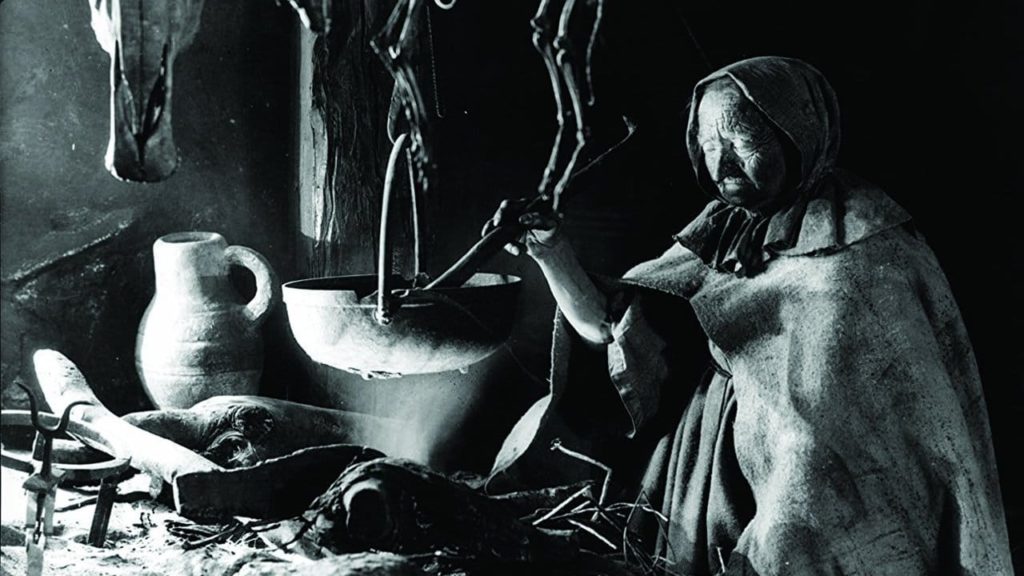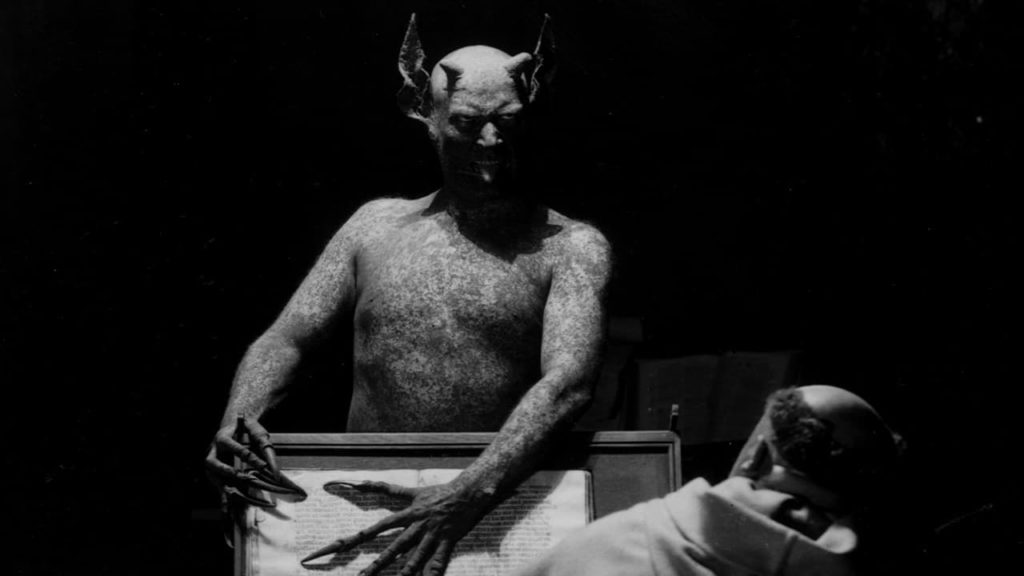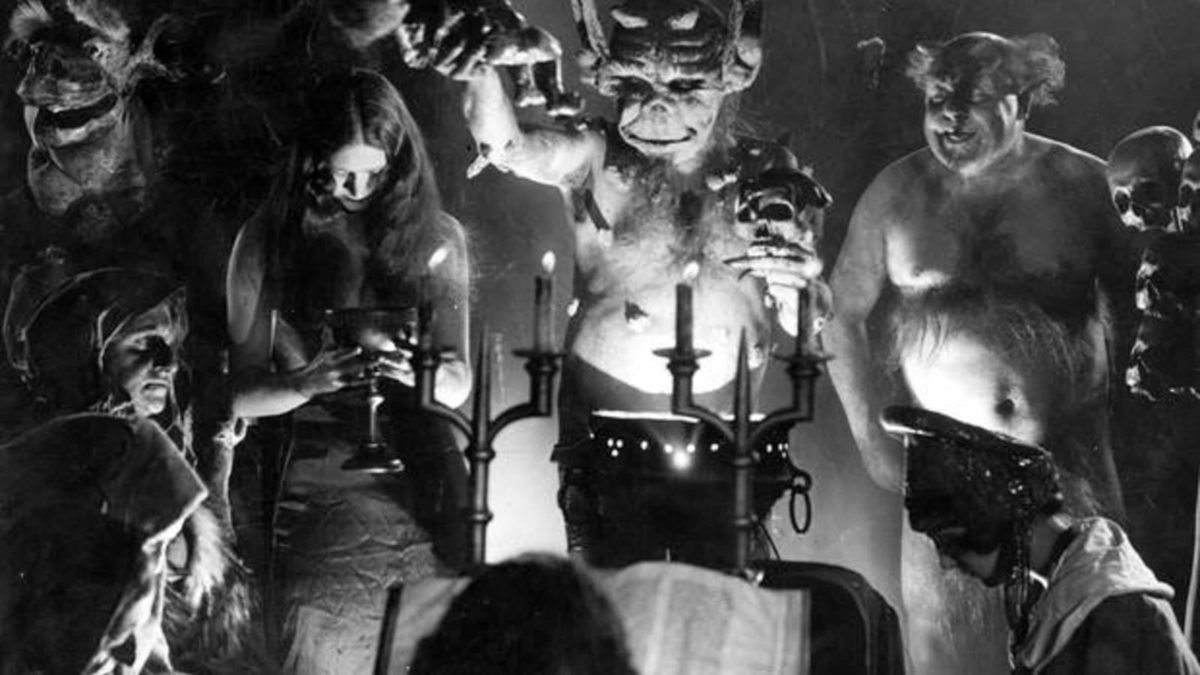Documentaries did not properly exist in 1922 as a cinematic form. That year, the American film Nanook of the North by Robert J. Flaherty was released, which essentially invented the documentary format as we most often see it: Extended, largely unstaged footage of “the real world” in the spirit of early cinema “actualities,” edited together with some commentary, that serves to teach its viewers about a topic, theme, or event. (Never mind that Flaherty did in fact stage and manipulate large portions of his footage, even changing the name of its central character.)
Thus, when Benjamin Christensen released Häxan that same year, he did not have a large corpus of documentary films to use as a basis, essentially inventing a variation on the format himself. Häxan is not really a documentary, as nearly all of its footage is a cinematic construction filmed at a Danish studio of an invented scenario. “Essay film” would probably be the most apt descriptor, and is indeed the term that Wikipedia uses.
Nonetheless, Häxan (Swedish for “The Witch”) feels quite a bit like a documentary in purpose and structure. Rather than a linear narrative, it strings together thematic segments with a blend of educational content and stagings of scenarios that illustrate the topic: witch-hunting by religious zealots through the ages.

The film is broken into seven chapters, each approximately fifteen minutes: The first part is a lecture-style segment outlining a religious history of the belief in demons that eventually evolved into witch-burning. The second segment reenacts some medieval scenes of Satan and witches causing trouble near a monastery, as if to illustrate what these historical Christians believed was happening.
The film’s third, fourth, and fifth chapters present the most substantial portion of the film, three parts of a single, staged, fictional story about the prosecution of a suspected witch during the Middle Ages. Christensen uses it as an example of what an actual witch-hunting might have looked like. We witness lurid scenes both real and imagined, including torture, a “Witches’ Sabbath,” sexual fantasies, and a burning at the stake.
Häxan’s final two chapters serve as a conclusion in a more directly didactic mode, reframing the previous depictions of witches as the byproduct of mental health. Part 7, in particular, is the equivalent of a PSA video teachers might have shown in health class 50 years ago to teach about mental illness and how it can manifest in various criminal behaviors.
Though the film has an educational spin, its richest pleasures lie in the incredible horror filmmaking of its middle section. It’s some of the most stirring and engaging horror imagery in cinema history up to that point. Maren Pedersen has some haunting close-ups as the accused witch, her face chiseled into desperation. The shots of torture devices in action are occasionally stomach churning. Christensen himself appears frequently as Satan, the personification of evil impulses.

Christensen’s stated objective is to teach that witchcraft and Satanic possession are not real — they are fictions manifest of misunderstanding societies and unhealthy individuals. Repeatedly, Christensen pleads this in its too many intertitles. And yet, there is absolutely no question that he is titillated and enraptured by the very thing he is denouncing. This film is, at its best, a rad heavy metal album cover come to life. The imagery is creepy and arresting. The filmmaking inventive, almost woozy: For example, Christensen uses a masterful double-exposure with an on-rails tracking shot to create a brilliant effect of witches flying against a zooming background. It’s the best depiction of the classic image of a witch on a broomstick I’ve ever seen.
Rather than detached or academic, the way you’d expect from a quasi-documentary, Häxan is full of emotionally fertile and immersive filmmaking: Consider a scene of alternating shots during the questioning of the suspected witch. It shows the disorienting whiplash of coercive interrogation that Pedersen’s weaver that causes her to break down and confess, and creates a similar disorientation about the nature of the realities we’ve seen within in the viewer.
The horror imagery is so compelling that it overwhelms the rest of the movie and makes me wish that Christensen had ditched the history lesson and made a straightforward horror film, perhaps an anthology of witch and possession stories. The educational content is moot a century later; anyone watching this is here for the historic filmmaking rather than a lecture. A properly moody and frights-first version of Häxan could very well have been a full masterpiece.
Unfortunately, the film’s score (at least as captured in the Criterion transfer) is a bit of a miss, as it’s an eclectic blend of classical “greatest hits” that don’t match the eeriness of the horror content. The worst offender is a loop of Beethoven’s Pathetique Sonata that goes on forever and is tonally out of place.
I opted instead to listen to the commentary track by Danish film historian Casper Tybjerg, available on the Criterion release and on the Criterion Channel. It is an illuminating overview, giving insight into the cinematic technique of the film, Christensen’s career, and the historical background of witch-burning. Christensen got many of his details correct, although he missed a few: Most outrageously, the number of actual witch-burnings cited, a ludicrous 50 million, was based on a since-debunked calculation, where the actual number was probably 0.1% that many, closer to 50,000.
Häxan is ultimately a fascinating and compelling curiosity, but an inessential curiosity nonetheless. I highly recommend it for horror enthusiasts; others may find the overall experience a hair tedious, though certainly a step forward in stunning dark imagery.
Is It Good?
Very Good (6/8)
Dan is the founder and head critic of The Goods. Follow Dan on Letterboxd. Join the Discord for updates and discussion.


2 replies on “Häxan (Haxan: The Witch) (1922)”
Sorry, but it just sticks out so starkly, that somebody wrote an intertitle claiming that if you were a woman you basically had about a 20% chance of being burned as witch if you lived in Europe between the years 1300 and 1800. That’s some *champion* innumeracy.
According to Tybjerg’s commentary, the original source of this number is that one historian took an account of witch-burning in a specific village over a few years of hysteria, and extrapolated it across all of Europe for five centuries. Crazy stuff.